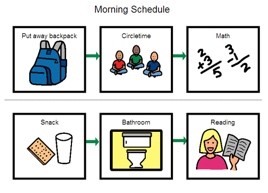A 101 Guide for Visual Schedules

Specific routines and schedules are all around us—in our homes, workplaces, schools, and community spaces. Whether you check off tasks included on your to-do-list of chores or organize an itinerary for your next travel destination, these are both examples of using visual schedules without even realizing it to help you stay on track. As adults benefit from these visual supports, children can easily reap the benefits of incorporating these types of schedules into everyday living. This guide will give a brief definition and outline important components when making and implementing visual schedules.
What are they?
Visual schedules are visual representations of what is going to happen throughout the day or within a task or activity. They can include pictures, drawings, written words, and lists to conceptualize each expectation.
What do they look like?
Visual schedules vary in appearance and are adaptive to the learner’s ability. Some learners may use picture icons with or without words, whereas some learners have the ability to make their own visual schedule, such as writing out a list with written words on a piece of paper.
Where are they located?
Visual schedules can be portable, for example, on a laminated sheet of paper or attached to a clipboard. They can also be fixed to a permanent place, like on a refrigerator or bedroom door. Always ensure the visual schedule is visible or easily accessible to the child during the rest of their activities.
When is it helpful?
A visual schedule is helpful for breaking down a task that has multiple steps, to ensure the teaching and compliance of those steps. For example, you can break down the task of handwashing with pictures and words to narrate each step of the process. Visual schedules provide clear information needed to understand what is expected and where to go next as the child moves throughout the day. It is also helpful decreasing anxiety and rigidity surrounding transitions by communicating when certain activities will occur. Visual schedules can be created for various activities such as within the classroom, special occasions, and general day-to-day planning.
What are some benefits?
- Provides structure and predictability to the day
- Reinforces and supplements verbal instructions
- Supports literacy development
- Allows change to be introduced easily
- Plays to the strengths of visual learners (but is still helpful for all types of learners)
- Provides independence


Eyas Landing is a therapy clinic with a mission to provide evidence-based and family-centered therapy services for children, adolescents, and their families. The primary goal is to deliver relationship-based interventions within the most natural environments and to empower families to reach their full potential. To achieve this goal, our highly educated, compassionate staff dedicates time and expertise to create experiences that maximize therapeutic outcomes. The strength, determination, and perseverance of our clients are evident as they succeed in therapy, and ultimately in their daily lives.
Eyas Landing offers a wide range of comprehensive services including Speech Therapy, Occupational Therapy, Physical Therapy, ABA Therapy, Social Work, Family Therapy, and Neuropsych testing. Services are provided throughout the Chicagoland area via Telehealth, In-Home, and in our state of the art clinic.
Want to learn more or you have a specific question? Feel free to connect with us here!



